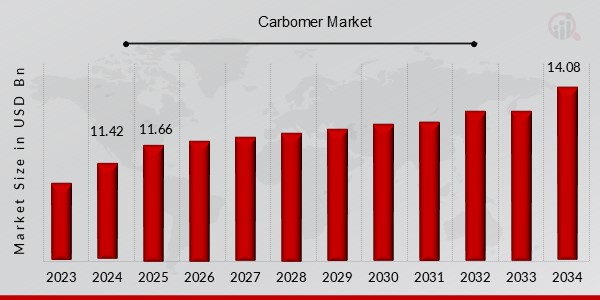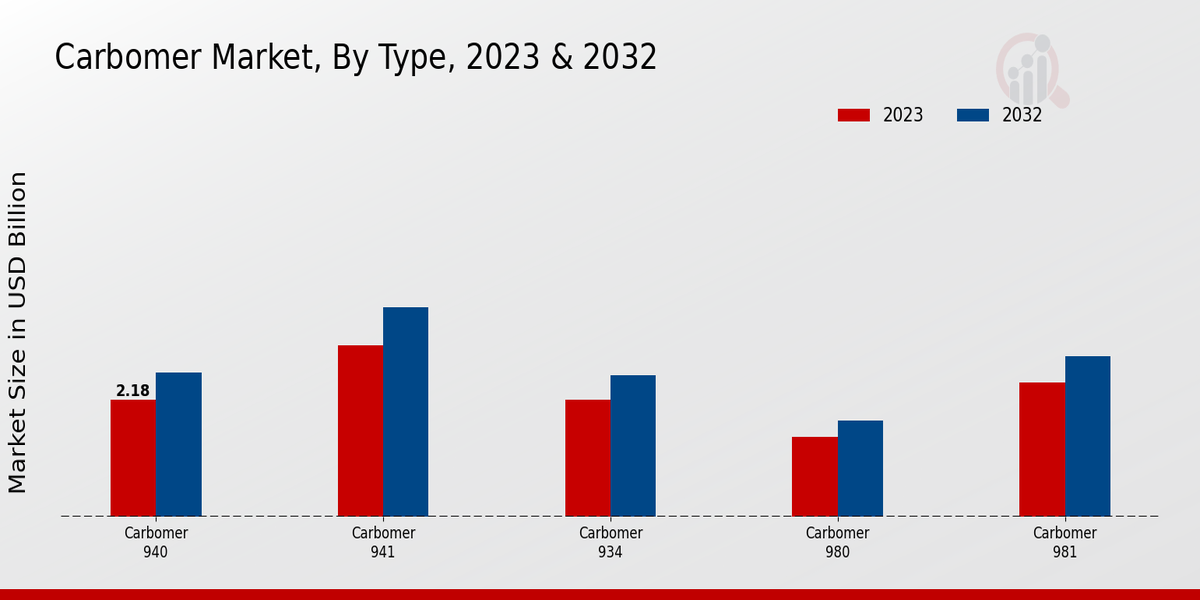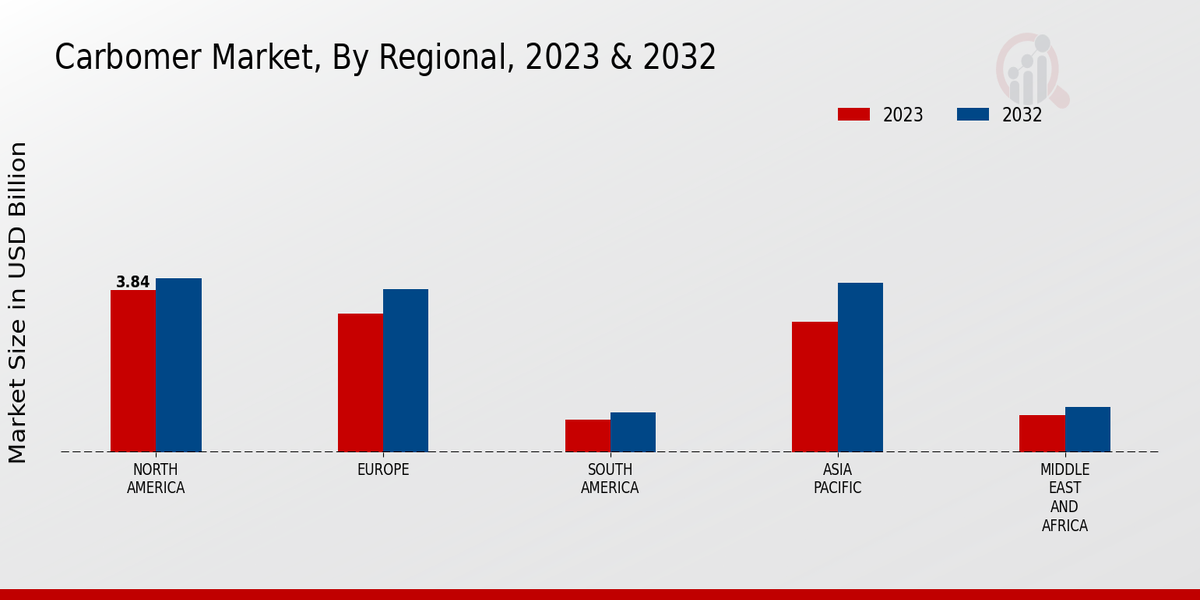Global Carbomer Market Overview
The Carbomer Market Size was estimated at 11.42 (USD Billion) in 2024. The Carbomer Industry is expected to grow from 11.66 (USD Billion) in 2025 to 14.08 (USD Billion) by 2034. The Carbomer Market CAGR (growth rate) is expected to be around 2.1% during the forecast period (2025 - 2034).
Key Carbomer Market Trends Highlighted
Some of the key factors that drive the market includes the unique thickening, suspending and stabilizing functionalities of carbomer. Expansion of the market base due to the increased growth in demand for personal care products, topically, cosmetics and skincare especially is due to the fact that carbomer improves the performance of such formulations as the consistency and stability. Indeed, the increase in the incidence of chronic diseases and the emergence of new technologies for drug delivery also still apply to the purchase of carbomer in the area of pharmaceutical industry.
Carbomer is looking for more exploration in the creation of novel products in different sectors. The same goes for food and beverage industries, Carbomer is also able to perform the role of technical grade thickener and stabilizer in this sector. Its biocompatibility in addition presents it an advantageous chemical for uses within the medical field, tissue scaffolding
Lately, the trend in the carbomer market has been that there has been an increasing focus on sustainable and green ingredients. Alongside, they are focusing on developing bio based and biodegradable products by carbomer to satisfy growing demand of consumers towards ecologically safe products. Besides, nanotechnology is also being incorporated to produce carbomer with added advantages such as thicker drug and controlled release of drugs.

Source: Primary Research, Secondary Research, MRFR Database and Analyst Review
Carbomer Market Drivers
Growing Demand for Personal Care and Cosmetics
Carbomer is a versatile polymer extensively used in the personal care and cosmetics industry. Its distinct properties including thickening, emulsifying, and stabilizing, make carbomer a crucial ingredient in a number of formulations ranging from skin care creams, lotions, shampoos, and hair conditioners. The growing demand for carbomer arises from the increased demand for personal care and cosmetic products. Factors such as growing disposable income, increased personal grooming, and the increased popularity of social media is anticipated to continue to drive personal care and cosmetic products which in turn is expected to drive the growth of carbomer.The Carbomer Market Industry is expected to grow significantly over the next several years.
Expansion of the Pharmaceutical Industry
Most chemically manufactured materials are utilized in industrial activities, and a few are used in the medical sectors. Carbomer is highly used in the pharmaceutical industry as a thickening agent, suspending agent, and binder in the formulation of formulations carbomer. Increasing the pharmaceutical industry, especially in the emerging world, is one of the factors for boosting carbomer market growth. Growth of the pharmaceutical industry is driven by increasing incidences of chronic diseases, the discovery of new drug delivery systems, and the rise in demand for generic medications.This increase in the end-user industry is instrumental in determining the growth of the carbomer market in the future.
Technological Advancements and New Applications
There is a range of new applications of carbomer due to the advanced technologies in this field. First of all, bio adhesive carbomers are widely used in the pharmaceutical industry to improve the results of drug delivery. As a thickener and stabilizer, carbomer is extensively used in the food industry. For instance, it is one of the core ingredients of sauces, dressings, and beverages that are widely consumed. Another field where carbomers find their application is the industry, including oil and gas, mining, and construction.These examples illustrate that the number of applications of carbomer is rapidly grow, which supports the development of its market.
Carbomer Market Segment Insights
Carbomer Market Type Insights
The growth of the Carbomer Market is driven by rising demand in various industries, particularly personal care and pharmaceuticals. As a synthetic polymer, Carbomer is widely utilized in many end-use industries, including personal care, pharmaceuticals, and food. In personal care, it finds application as a thickener, stabilizer, and emulsifier, among other things. There are five main types of Carbomer in the Carbomer Market: Carbomer 940, Carbomer 941, Carbomer 934, Carbomer 980, and Carbomer 981. Carbomers 940 and 941 are among the most frequently used on the market.Carbomer 940’s efficiency level in thickening is highest; consequently, personal care products like lotions, creams, and shampoos usually contain it. Furthermore, Carbomer 941’s viscosity and turbidity levels are lower, and it is an ideal type for applications requiring a clear solution and low viscosity; hence, it can be added to gels and clear final formulations. The fast expansion of the personal care industry is partly attributable to the demand for Carbomer because it enables the improvement of the texture, stability, and appearance of many skincare and haircare products.Moreover, consumers are becoming increasingly aware of the benefits of Carbomer in skincare products. Polycarbophil and carbo method, an acrylic resin, are well-known Carbomer products used in pharmaceuticals as a thickener for both oral and topical formulations. Rising rates of chronic and acute conditions coupled with the advent of novel drug-delivery systems are also likely to fuel growth in the healthcare market.

Source: Primary Research, Secondary Research, MRFR Database and Analyst Review
Carbomer Market Application Insights
One of the defining factors influencing Carbomer Market is the probable contribution of the application segment. The Personal Care segment held a dominant market in 2023, accounting for about 35.1% of the overall Carbomer Market. The boosting factor of personal care applications is ascribed to the thickening, suspending, and stabilizing characteristics associated with carbomers. They are used in skincare, haircare, and oral care applications. The Pharmaceuticals segment is expected to register a remarkable CAGR during the period on the grounds of the increased use of carbomer as a binding, disintegrating, or suspending agent in drug formulations.On the other hand, the Food Industry segment is assumed to make steady growth due to the boosting thickening and stabilizing applications in food items, including sauce, dressing, and beverages. Lastly, the Industrial Manufacturing and Construction segments are also expected to be contributors to the overall market growth. The importance of these trends is validated by the utilization of carbomer as a thickener, binder, or suspending agent in industrial or construction applications.
Carbomer Market Form Insights
The Carbomer Market is segmented into powder, gel, and liquid forms. Among these, the powder form held the largest market share in 2023, accounting for over 55% of the revenue. The powder form is preferred due to its versatility and ease of handling. It is widely used in personal care products, such as lotions, creams, and shampoos, as it helps to thicken and stabilize the formulations. The gel form of carbomer is expected to witness the highest growth rate during the forecast period, owing to its increasing use in pharmaceutical and biomedical applications.Carbomer gels are used as thickening agents in ophthalmic preparations, wound dressings, and drug delivery systems. They offer controlled release of active ingredients, improved biocompatibility, and enhanced patient compliance. The liquid form of carbomer is primarily used in industrial applications, such as paints, coatings, and adhesives. It imparts thickening, suspending, and stabilizing properties to these formulations, improving their performance and durability.
Carbomer Market End User Insights
The end user segment of the Carbomer Market is categorized into cosmetic companies, pharmaceutical companies, food and beverage companies, industrial manufacturers, and construction companies. Cosmetic companies are the largest end users of carbomer, accounting for approximately 30% of the market. They use carbomer as a thickening, suspending, and emulsifying agent in a wide range of personal care products such as lotions, creams, shampoos, and conditioners. Pharmaceutical companies are the second largest end users, accounting for approximately 25% of the market.They use carbomer as a binder, disintegrant, and suspending agent in various drug formulations. Food and beverage companies account for approximately 20% of the market. They use carbomer as a thickening, gelling, and stabilizing agent in a variety of food and beverage products such as soups, sauces, and dressings. Industrial manufacturers account for approximately 15% of the market. They use carbomer as a thickener, binder, and suspending agent in a variety of industrial products such as paints, coatings, and adhesives. Construction companies account for the remaining 10% of the market.They use carbomer as a thickener, binder, and suspending agent in construction materials such as cement, mortar, and plaster.
Carbomer Market Viscosity Insights
The Carbomer Market is segmented based on viscosity into Low, Medium, and High Viscosity. Among these, the medium viscosity segment held the largest market share and is projected to continue its dominance over the forecast period. The growing demand for medium viscosity carbomer in personal care and pharmaceutical applications is attributed to its ability to provide excellent thickening, suspending, and stabilizing properties. The low viscosity segment is expected to witness a steady growth rate due to its increasing use in water-based formulations and as a suspending agent in liquid products.The high viscosity segment, though accounting for a smaller share, is anticipated to grow at a significant pace owing to its superior thickening and gelling capabilities, making it suitable for use in high-performance applications such as oilfield drilling fluids and adhesives.
Carbomer Market Regional Insights
The regional segmentation of the Carbomer Market provides insights into the market's geographical distribution and growth potential. North America held the largest market share in 2023, accounting for approximately 35% of the revenue. The region's dominance can be attributed to the presence of well-established pharmaceutical and personal care industries. Europe followed North America with a market share of around 30%. The region's strong healthcare infrastructure and growing demand for personal care products contribute to its significant market size.APAC is projected to be the fastest-growing region, with a CAGR of 4.5% during the forecast period 2024-2032. The region's expanding population and rising disposable incomes are driving the growth of the carbomer market in APAC. South America and MEA are also expected to experience steady growth due to increasing urbanization and improving healthcare systems.

Source: Primary Research, Secondary Research, MRFR Database and Analyst Review
Carbomer Market Key Players And Competitive Insights
The competitive insights of the Carbomer Market reflect a landscape characterized by continuous innovation and strategic expansions by various stakeholders. The market is marked by the presence of several established and emerging players who are actively engaged in developing a diverse range of carbomer products tailored for specific applications. This includes personal care formulations, pharmaceuticals, and coatings, resulting in a broad spectrum of utility across multiple industries. The ongoing research and development efforts by these companies are aimed at enhancing the effectiveness of carbomers and exploring new areas of application, which keeps the market dynamic and competitive. The Carbomer Market industry demonstrates a propensity for collaboration and partnerships, with companies often aligning with academic and research institutions to push the boundaries of product capabilities and performance. The Competitive Landscape is further characterized by strategic mergers and acquisitions, allowing leading carbomer players to consolidate resources and expand their geographic reach. Innovation in production techniques is also a focal point, leading to increased efficiency and sustainability in manufacturing practices.Aqua is an example of a leading player in the Carbomer Market that has established a strong foothold through its diversified product portfolio targeting various end-use industries. The company focuses on high-quality carbomer formulations that cater to the needs of personal care and cosmetic manufacturers while ensuring compliance with safety standards. Aqua places a significant emphasis on research and development, allowing it to maintain its competitive edge by introducing novel applications for its products. The company's commitment to sustainability is evident in its endeavors to minimize environmental impact during production processes and its continuous exploration of bio-based materials. Aqua’s market strategies include regional expansions and targeted marketing efforts, which enhance their visibility and access to diverse markets. This focused approach enables the company to respond effectively to shifting consumer preferences and industry trends, thus reinforcing its standing among the Major players in the Carbomer Market.On the other hand, another key player, Lubrizol, has built its reputation in the Carbomer Market through consistent product innovation and strategic positioning. The company leverages its extensive R&D capabilities to manufacture high-performance carbomers that find applications in multiple sectors, including pharmaceuticals and food industries. Lubrizol's commitment to quality assurance and regulatory compliance enhances its appeal to customers seeking reliable ingredients. The company adopts a customer-centric approach, tailoring its offerings to meet specific client needs and industry requirements. Furthermore, Lubrizol invests in sustainability initiatives, focusing on reducing carbon footprints and promoting eco-friendly practices throughout its supply chain. By maintaining strong relationships with distributors and leveraging its presence, Lubrizol effectively competes within the Carbomer Market Competitive Landscape, ensuring its continuous growth and relevance in an evolving industry.
Key Companies in the Carbomer Market Include
- AkzoNobel
- Eastman Chemical
- Ashland Specialty Chemicals
- Dow Chemical
- Lonza
- Croda International
- Evonik Industries
- Sanyo Chemical Industries
- Arkema
- SigmaAldrich
- Clariant
- BASF
- Elementis
- Huntsman Corporation
- Lubrizol
Carbomer Market Industry Developments
The carbomer market continues to demonstrate steady growth, with a valuation of approximately USD 10.94 billion in 2024 and projected to reach USD 13.19 billion by 2032, representing a CAGR of 2.1%. Recent developments indicate increased usage in pharmaceuticals and cosmetics, driving demand for formulations with enhanced stability and efficacy. Innovations in production technology and raw material sourcing are shaping the landscape, allowing manufacturers to meet evolving regulatory standards and consumer preferences. Major players are expanding their product lines to include bio-based alternatives, which align with sustainability trends and reduce environmental impact. Notable investments in research and development are also underway to explore new applications in various sectors, including personal care and household products. Economic shifts and supply chain disruptions due to geopolitical factors are other elements influencing market dynamics, necessitating adaptive strategies among industry stakeholders. As consumer awareness regarding ingredient transparency grows, the demand for high-quality and safe carbomers is expected to increase, further bolstering market potential through 2032. The ongoing emphasis on product innovation and compliance with safety regulations is essential for market players aiming to leverage growth opportunities in this sector.
Carbomer Market Segmentation Insights
Carbomer Market Type Outlook
- Carbomer 940
- Carbomer 941
- Carbomer 934
- Carbomer 980
- Carbomer 981
Carbomer Market Application Outlook
- Personal Care
- Pharmaceuticals
- Food Industry
- Industrial Manufacturing
- Construction
Carbomer Market Form Outlook
Carbomer Market End User Outlook
- Cosmetic Companies
- Pharmaceutical Companies
- Food and Beverage Companies
- Industrial Manufacturers
- Construction Companies
Carbomer Market Viscosity Outlook
- Low Viscosity
- Medium Viscosity
- High Viscosity
Carbomer Market Regional Outlook
- North America
- Europe
- South America
- Asia Pacific
- Middle East and Africa
| Report Attribute/Metric |
Details |
| Market Size 2024 |
11.42(USD Billion) |
| Market Size 2025 |
11.66(USD Billion) |
| Market Size 2034 |
14.08(USD Billion) |
| Compound Annual Growth Rate (CAGR) |
2.1% (2025 - 2034) |
| Report Coverage |
Revenue Forecast, Competitive Landscape, Growth Factors, and Trends |
| Base Year |
2024 |
| Market Forecast Period |
2025 - 2034 |
| Historical Data |
2020 - 2024 |
| Market Forecast Units |
USD Billion |
| Key Companies Profiled |
AkzoNobel, Eastman Chemical, Ashland Specialty Chemicals, Dow Chemical, Lonza, Croda International, Evonik Industries, Sanyo Chemical Industries, Arkema, SigmaAldrich, Clariant, BASF, Elementis, Huntsman Corporation, Lubrizol |
| Segments Covered |
Type, Application, Form, End User, Viscosity, Regional |
| Key Market Opportunities |
· Rising demand for cosmetics · Expanding the pharmaceuticals sector · Growth in personal care products · Increased applications in the food industry · Advancements in biotechnology processes |
| Key Market Dynamics |
Rising demand in personal care, Expanding pharmaceutical applications, Increasing use in cosmetics, Growth in food industry, Advancements in manufacturing technology |
| Countries Covered |
North America, Europe, APAC, South America, MEA |
Frequently Asked Questions (FAQ) :
The carbomer market is expected to have an overall valuation of 11.42 billion USD in 2024.
By 2034, the carbomer market is expected to reach an overall valuation of 14.08 billion USD.
The compound annual growth rate (CAGR) for the carbomer market during the forecast period from 2025 to 2034 is projected to be 2.1%.
Key applications of carbomers include personal care products, pharmaceuticals, and industrial coatings, where they function as thickeners and stabilizers.
North America and Europe are expected to dominate the carbomer market due to high demand in personal care and pharmaceutical applications.
The growth of the carbomer market is driven by increasing demand in the cosmetic and personal care industries, as well as advancements in pharmaceutical formulations.
Key competitors in the carbomer market include major chemical companies specializing in specialty chemicals and polymers.
The market size for carbomers in North America is a significant portion of the overall 10.94 billion USD market size in 2023.
Trends such as increased demand for natural ingredients and eco-friendly formulations are influencing the carbomer market from 2024 to 2032.
Carbomers play a crucial role in cosmetic formulations by providing viscosity, stability, and improved texture, enhancing product performance.
















